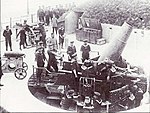28 cm Haubitze L/12
| 28 cm Haubitze L/12 | ||
|---|---|---|
Breech Horizontal sliding-block | | |
| Recoil | Hydro-gravity | |
| Elevation | 0° to +70° | |
| Traverse | 360°[1] | |
| Rate of fire | 1 round per 4 minutes | |
| Muzzle velocity | 379–425 m/s (1,240–1,390 ft/s) | |
| Effective firing range | 9.9 km (6.2 mi) | |
| Maximum firing range | 10.4 km (6.5 mi)[1] | |
The 28 cm Haubitze L/12 was a
Description
The 28 cm Haubitze L/12 in Mittelpivotlafette C/92 was a design of the late 19th century initially intended for coastal defense. The theory of operation was a low-velocity howitzer firing a large shell at a high-angle was more likely to destroy an enemy ship by penetrating its thin deck armor than a high-velocity low-angle gun attempting to penetrate its thicker belt armor. The downside was that high-angle fire was harder to aim correctly so more howitzers would be needed to defend an area from attack. However, if the area was constrained by geography like a port at the mouth of a river the navigation channels could be measured ahead of time and firing ranges calculated. A complicating factor was as naval artillery progressed their size and range soon eclipsed its range.[2]
In the coastal defense role it was mounted on a large geared circular base that was set in concrete. There was also a 60 mm (2.4 in) thick armored dome to protect the gun crew. Recoil forces were absorbed by a combination of the gun cradle moving up an inclined plane and two
In the
Combat history
World War I
During the First World War there was a four gun battery at the Bismark fortress that participated in the defense of the German colony of Tsingtao during the Siege of Tsingtao in 1914.[4] A four gun battery was also moved from the German port of Wilhelmshaven to Blankenberge in Belgium to defend against an allied seaborne invasion.[1]
Prior to the Great War, in 1902, the
World War II
Supposedly it saw action in the assault on Sevastopol in 1942 under the command of 11th Army of Army Group South, but this has not been confirmed.[3] In a personal photo album, owned by former Mountain Troops general Gheorghe Manoliu, commander of the 4th Mountain Division, a piece of artillery that seems to be a Haubitze L/12 was identified in a picture taken during the battle for Sevastopol.
Weapons of similar era and performance
- 12-inch coast defense mortar - A US coastal defense mortar.
- 28 cm howitzer L/10 - A Japanese coastal defense howitzer based on an Armstrong design.
- Mortier de 270 mm modèle 1889 - A French coastal defense mortar
- Obice da 280 - An Italian coastal defense howitzer based on an Armstrong design.
Photo Gallery
-
28-cm-Küstenhaubitze L-12 (coastal howitzer)
-
A picture of a coastal howitzer from encyclopedia britannica 1910.
-
One of the four 28 cm coastal howitzers at fort Bismarck Tsingtao.
-
One of the Blankenberge howitzers sabotaged by the retreating Germans.
Notes
- ^ )
- OCLC 44779672.
- ^ a b Gander and Chamberlain, p. 208
- ^ "German Colonial Uniforms". s400910952.websitehome.co.uk. Retrieved 2018-09-23.
- OCLC 1031381786.
References
- Engelmann, Joachim and Scheibert, Horst. Deutsche Artillerie 1934-1945: Eine Dokumentation in Text, Skizzen und Bildern: Ausrüstung, Gliederung, Ausbildung, Führung, Einsatz. Limburg/Lahn, Germany: C. A. Starke, 1974
- Gander, Terry and Chamberlain, Peter. Weapons of the Third Reich: An Encyclopedic Survey of All Small Arms, Artillery and Special Weapons of the German Land Forces 1939-1945. New York: Doubleday, 1979 ISBN 0-385-15090-3
- Hogg, Ian V. German Artillery of World War Two. 2nd corrected edition. Mechanicsville, PA: Stackpole Books, 1997 ISBN 1-85367-480-X




